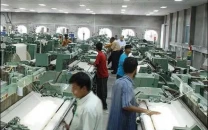K-P expected to present Rs610b budget next week
Inflated wage bill to eat into development funds for new schemes

Budget session chaos, figures provide indication of party’s rule. PHOTO: AFP
Even though the budget is effectively for nine months, it is marginally higher than the last budget passed in June 2017.
Sources in the Khyber-Pakhtunkhwa (K-P) Finance and the Planning and Development Departments said that the Pakistan Tehreek-e-Insaf (PTI) led provincial government is struggling to finance its Annual Development Programme (ADP).
Budget to come up to people’s expectations: Punjab CM
The finance department, they said, is hell-bent on limiting the provincial ADP to just Rs60 billion, excluding the share of the district governments which will amount to 30 per cent of the total ADP (as per the local government act).
“The actual figure for the ADP would be between Rs180 billion to Rs190, compared to the Rs208 billion for the ADP in FY 2017-18, if the political government does not inflate it,” said a senior official of the K-P P&D department while requesting not to be named since he was not authorised to speak to the media.
“The foreign project assistance (direct revenue from foreign organisations) is expected at Rs80 billion, while the district ADP will be between Rs30 to R35 billion depending on the volume of the total ADP which has yet to be finalized with the finance department maintaining that it has a Rs60 billion limit,” the official explained.
The official, who had attended a meeting on the ADP headed by K-P Chief Minister Mahmood Khan on Tuesday, said that officials from the finance department insisted on keeping the ADP to realistic figures.
He further said that the finance department had expressed its concerns over the rapidly increasing expenditures on paying salaries and pensions.
“The finance (officials) told the meeting that regularisation of around 5,000 government employees during the last PTI government had created huge financial implications and had caused the fiscal space for developmental schemes to shrink,” the official said.
The finance secretary, he claimed, had told the meeting that if non-development expenditures such as salaries, pensions and other non-salary expenditures continued to rise at the current pace, the province would have no money for developmental schemes within a decade.
The meeting, though, ended with the agreement that the government will not present any outlay for new development schemes and keep allocations for ongoing projects — including a massive allocation for the Bus Rapid Transit project in Peshawar — to balance its expenditure requirements.
Govt retains restrictions on non-filers as NA passes mini-budget
“We have to give Rs10 billion to the BRT this fiscal year,” the official said, adding that apart from the BRT, they also had to balance the requirements of other mega-projects such as the Swat Motorway, the Billion Tree Tsunami and over 1,000 other developmental schemes which will be carrying forward from the last fiscal year.
The official noted that despite the belt-tightening measures, the P&D department had received proposals for new schemes worth Rs60 billion, but it was unclear whether enough would be available to build them.
As per the finance department’s calculations, the bucket for paying salaries and pensions has jumped 15.5 per cent from Rs271 billion last year to Rs313 billion this year.
Documents from the K-P finance department, available with The Express Tribune, show that the provincial budget for paying salaries and pensions has increased by Rs266 billion over the past 10 years with an average annual increase of Rs24 billion.
Published in The Express Tribune, October 6th, 2018.






1726134115-0/BeFunk_-(41)1726134115-0-208x130.webp)






COMMENTS
Comments are moderated and generally will be posted if they are on-topic and not abusive.
For more information, please see our Comments FAQ